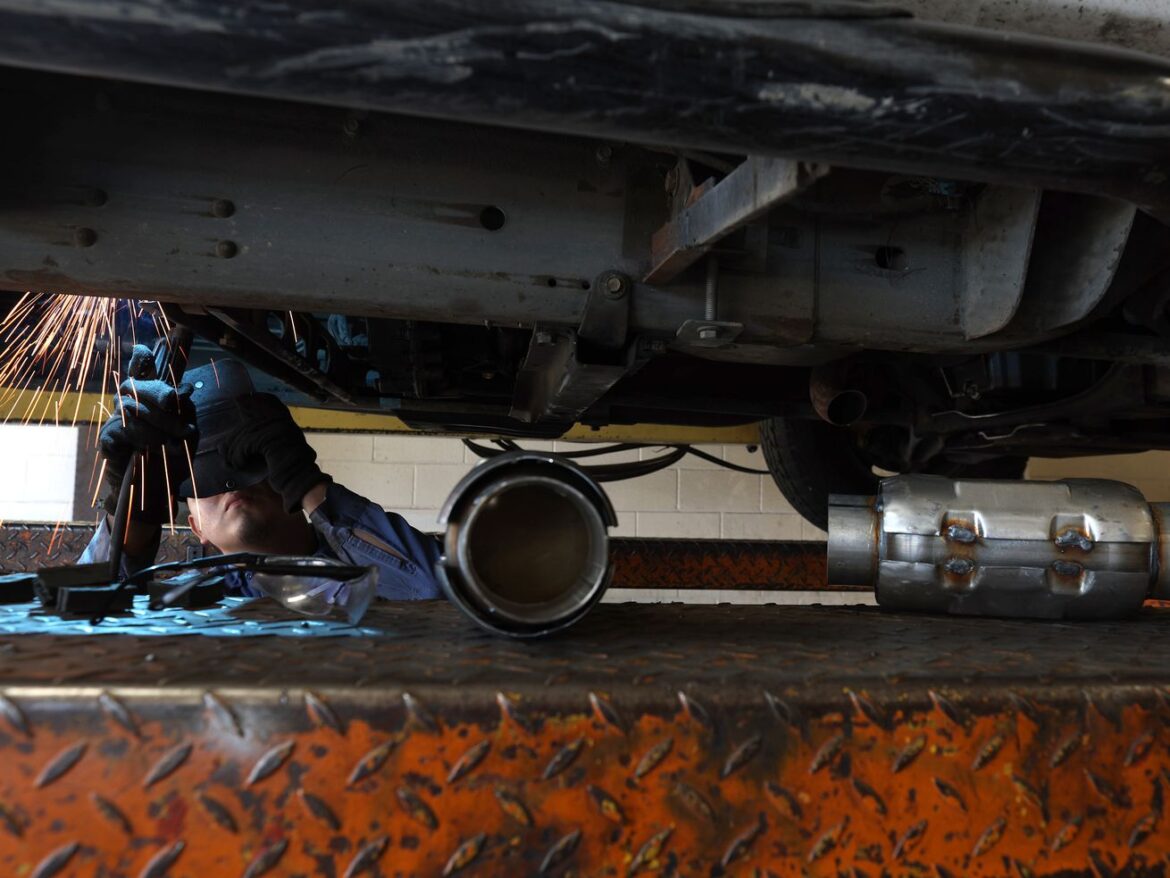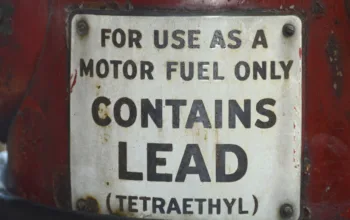The nationwide epidemic of catalytic converter thefts, explained.
When Josy turned the ignition on her 2010 Prius one morning this February, she heard an unsettling rattle coming from underneath her car. Her girlfriend, Glory, unfortunately knew the sound all too well.
Once again, thieves had targeted the cars parked at Glory’s Indianapolis apartment complex, searching for catalytic converters — the valuable, canister-like part of the car responsible for transforming harmful emissions into less-polluting gas. Glory, a 23-year-old librarian, already had her “cat” stolen from her 2016 Kia Sportage twice, once in April 2021 and another time in March 2022. Now it was Josy’s turn.
Glory and Josy — whose last names are being withheld to protect their privacy — are not alone. From San Diego to Boston, nationwide catalytic converter thefts appear to be at a historic high. Insurance claims for these thefts increased from 16,660 claims in 2020 to 64,701 in 2022, according to the National Insurance Crime Bureau’s latest report released last week.
/cdn.vox-cdn.com/uploads/chorus_asset/file/24666260/Screen_Shot_2023_05_18_at_12.01.46_PM.png)
At first glance, catalytic converters seem like a weirdly specific part to steal. But there’s a reason for that — they’re rich in precious metals, such as platinum, palladium, and rhodium. A thief can earn a couple hundred bucks from a typical catalytic converter. (In the US, secondhand converters aren’t reused in cars. Rather, these parts eventually end up at refineries that process the metal.)
The thefts are brazen and can occur in under 90 seconds, and have even taken place in broad daylight. Police historically have had a hard time tracking thefts because it’s near impossible to identify catalytic converters once they’re stolen. In some rare cases, when someone has caught a thief red-handed, it has ended in bloodshed.
It can cost up to thousands of dollars and weeks of waiting to get a converter replaced. Like any other car part, catalytic converters are specific to the make and model of the car. (While most cars have one catalytic converter, some have two and others can have up to four.) If you have an electric vehicle, you’re in luck — only combustion cars and hybrid vehicles have catalytic converters.
It’s easy to write off these thefts as random acts that occasionally get featured on the 11 o’clock news. But the scale is much, much bigger than that. Last November, the Department of Justice cracked down on a $545 million nationwide theft ring. Law enforcement arrested 21 people and seized “millions of dollars in assets, including homes, bank accounts, cash, and luxury vehicles.”
If neighborhood listservs, local news segments, and frustrated tweets are to be believed, it’s likely that 2023 will continue to see higher than normal numbers. Drivers can take some steps to deter theft — more on those below — but the problem has gotten to a point where lawmakers and car manufacturers have to act.
What is a catalytic converter anyway?
The science behind your catalytic converter is nothing short of incredible.
Crudely put, a catalytic converter is a small loaf-sized metal tube under your car that takes the gasses produced from your engine and makes them less harmful to the environment. If you crack it open, the insides resemble a honeycomb. Those insides — usually composed of platinum, palladium, and rhodium, alongside some other metals — are what chemically “converts” that gas.
/cdn.vox-cdn.com/uploads/chorus_asset/file/24666241/1408112449.jpg)
Justin Sullivan/Getty Images
Let’s zoom out for a system-wide view. You’ve probably heard of a 4- or 8-cylinder engine. Every time you start your engine, thousands of tiny combustions in each of those cylinders give your car the energy to move, explained Talena Handley, a California-based mechanic and owner of Girlie Garage, a car education organization for women.
Those mini-combustions also create fumes that need some way to exit the engine. Your converter takes those fumes and transforms them into nitrogen, carbon dioxide, water, and oxygen. Then the exhaust travels through the muffler and out the tailpipe.
Before the invention of the catalytic converter, cars simply just … let those unchanged fumes into the atmosphere. It wasn’t until the EPA passed the Clean Air Act in 1970 that vehicle emissions were regulated in the US. By 1975, most cars had to be equipped with a catalytic converter in order to meet those emission goals. (A fun unintended consequence of that legislation? The widespread adoption of catalytic converters forced companies to remove lead from gasoline since it can damage the converter. By 1986, lead was fully eliminated from gasoline in the US.)
The crime uptick and how these thefts happen
One of the questions surrounding the meteoric rise in catalytic converter theft is “Why now?” The answer, as you may have guessed, has something to do with changes in the supply chain wrought by the pandemic.
Platinum, palladium, and rhodium are all scarce metals that have to be mined. Rhodium, the most rare and valuable of the three, is mined mostly in South Africa, followed by Russia.
Although thefts slowly began creeping up in 2019, they grew in 2020 and boomed in 2021 mostly because of the pandemic, the experts I spoke with told me. Like everywhere else in the world, workers couldn’t mine, process, and ship these metals due to restrictions. And if they did, it’s likely there were other hurdles and disruptions along the supply chain.
The fact that people weren’t driving their cars as often during the beginning of the pandemic combined with higher valuations for these metals created a perfect storm to incentivize catalytic converter theft.
“There’s other people who are illegally enjoying the ride saying, ‘Okay, if these precious metals are up high, we’re going to go and take them,’” says Donovan Bates, the owner of DMV Recycling, a metal recycling company based in Virginia. He buys converters from both individuals and mechanic shops, and then later sells to a refinery.
/cdn.vox-cdn.com/uploads/chorus_asset/file/24667055/Screen_Shot_2023_05_18_at_4.54.28_PM.png)
Catalytic converters range in price, depending on the year, make, and model. Those that have more precious metals — like hybrid cars, such as the Toyota Prius — are more likely to be targeted. According to the Los Angeles Times, the Prius is the number one hit car in the West (and California the number one state for thefts, per the NICB), with its two catalytic converters running up to a grand each, making it a double whammy for thieves.
Other cars that are likely to be hit include fleet vehicles (such as USPS trucks, school buses, and even Oscar Mayer’s Wienermobile, which tend to sit unmonitored in lots when not in use) and anything with a higher clearance, including trucks and SUVs. Since these vehicles have more room under them, it’s easier for thieves to slip underneath, slice the converter out, and slide out undetected.
(It doesn’t always go smoothly — in February, an unsuspecting driver of a Ford Excursion in California had been asleep in a retail parking lot when a thief crawled under and began sawing. Awoken by the sound, the driver accidentally ran over the thief, killing them.)
Thieves usually operate in teams, according to Handley and Bates. Give a team an hour, and rows of cars in a parking lot will get hit. All it takes is an electric saw or other metal-cutting tool.
After a cat is stolen, you’re at a greater risk of getting hit again once you’ve replaced it, said Handley. “Because then they know that you’re vulnerable and they know you’re going to fix it,” she explained. “And if your car is still sitting in your driveway a month later with a new catalytic converter, that new catalytic converter actually has more fresh material in it. They’re going to hit you again.”
The number of catalytic converters a thief has in their possession matters. Each converter only has a tiny amount of precious metals, so it’s much more worthwhile to steal dozens, if not hundreds. In the US, most thieves will sell converters to several metal recyclers or scrap yards that aren’t checking for identification.
These middlemen, Bates says, will pay an individual or entity up front for a converter, and then sell to a refinery once they’ve accumulated enough worth selling. (To be clear, Bates’s company does track drivers and business licenses.) Because the processing machines are gigantic and require at least 2,000 pounds worth of material, most shops will need to sell around 800 converters at a time. Then the converters are crushed into dust and refined. The precious metals are then separated, sold to a final end user, and later recycled into new converters, dental fillings, jewelry, you name it.
How to protect yourself from catalytic converter theft
Beyond the typical safety tips of parking in a secure garage or in a well-lit place, there are a few steps you can take to give yourself an extra layer of protection.
The first thing you can do is contact your insurance company and see whether upgrading or changing your coverage makes sense for your needs. I spoke with several victims across the country, and the amount they paid for a replacement was contingent on their policy. It might mean you have a higher bill each month, but if you have a car that’s heavily targeted, don’t have a garage to park in, or live in an area that has had a spike in theft, it’s worth looking into.
Lyssa, a 39-year-old school teacher in Oakland, upgraded her insurance after her 2005 Toyota Highlander was hit three times in 2022. It wasn’t just her; her husband’s 2012 Prius was hit in 2020. At the time, they decided to take the buyout from their insurance instead of paying the $1,000 co-pay to replace the Prius’s converter. When the Highlander’s converter was cut out the first two times in September, they replaced it each time. But after round three, it was time to get better insurance (and an anti-theft cable welded to the converter — more on this below).
“It can be a really painful realization if you get the cheap insurance, like one of my coworkers did, and then lose your catalytic converter and then find out that you don’t have any coverage for that,” she says. “So you actually have to pay for the whole $3,000. Which, you know, if you’re driving an old Camry, that’s more than your car is worth.”
On the deterrence front, regardless of what model car you have, Handley recommends talking to your mechanic to install a “cat shield,” which is a sheet of metal that covers where the converter is. They range from $50-$500 (as with everything, the make and model of your car affect the price). Other options include cables that are similar to what you would see for a bike lock — those are a bit more affordable, but easier to break.
“The reason the cat shield actually deters people is because it takes a really long time and it’s very noisy,” Handley said. “It takes a longer time to cut through it, so if you have to linger to cut through it, you have a higher chance of attracting attention. If they’re really determined, they’ll still do it, though.”
The next course of action is etching your vehicle identification number (VIN) onto your catalytic converter, says Bates, the metal recycler. As mentioned above, converters don’t come that way. Recyclers who see an etched converter may be less likely to buy it, but it won’t stop a thief from stealing it. One company is creating VIN stickers and a database to track, but it’s not widely used among recyclers, Bates says.
“The real problem is that we don’t have a good infrastructure in place to stop catalytic converter theft,” Bates said.
He argues that either a state-based or federal government database for catalytic converters that is easily accessible for recyclers and repair shops could work. Manufacturers first would need to engrave VINs onto converters as part of their process to ease the cost and mental burden on drivers, but if there was a searchable database that allowed legal transfer of ownership, it would save a lot of headaches.
Sergeant Bob Carson of the Houston Police Department confirmed that identification is difficult for police, too. “If I stopped you with five catalytic converters in your car,” he said. “I couldn’t connect you to any specific vehicle.” Sometimes, he added, his reports could match a converter to the cut under your vehicle, but that is very uncommon.
The epidemic of thefts has prompted state and municipal governments throughout the country to act. In the past two years, several cities and states have proposed and enacted new laws or amended current ones to help combat theft, according to the National Insurance Crime Bureau.
Houston’s city council passed an ordinance in 2022 that requires metal recyclers to check more identification from mechanic shops and individuals, such as a business or driver’s license as well as the car’s VIN. The law came alongside community education programs to allow the secondary market to catch up, says Carson.
/cdn.vox-cdn.com/uploads/chorus_asset/file/24666268/Screen_Shot_2023_05_18_at_12.04.49_PM.png)
Based on preliminary data provided by the Houston Police Department, these initiatives seem to be working. Last year, the city saw 9,637 reported thefts, a jump from 2021’s 7,822 thefts, and 2020’s 1,793. Projected rates for 2023 hover around 4,000 reported thefts. (January and February had fewer than 700 thefts combined.) The Texas State Legislature is also looking to make catalytic converter theft a felony.
Should your converter get stolen, it’s advisable to contact your local police department and insurance company right away. Making a report will help give lawmakers and law enforcement a clearer picture of what’s going on in your area, and your insurance may be able to cover the cost of the stolen converter.
As for replacing your converter or the whole vehicle, that’s up to you. An older car might have a long wait time for a replacement part and the vehicle’s value may be less than the repair. States that don’t have as strict pollution or aftermarket part regulations may have a shorter wait period for a new converter. When looking for a professional, be sure to call at least three mechanics to price check, says Handley. She urges customers to also get a shield installed immediately after a theft.
“There is absolutely no regulation on automotive pricing,” Handley says. “At all. There can be two shops in the same parking lot and they will charge you different prices for the same thing.”
In the meantime, stay vigilant. We’ll see if the flurry of legislation and growing awareness begin reversing the nationwide trend.



